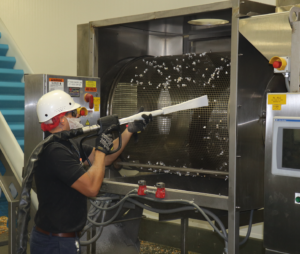Dry ice cleaning an innovative sanitation alternative in processing plants
Dry ice cleaning is an innovative cleaning technology that can save both time and money in the processing and packaging industry.
Equipment and facilities get dirty with ink, glue, grease, wax, plastic/rubber molding process residues, carbon residue, proteins, seasonings, crumbs and other build-up, which prevents equipment from operating at peak efficiency and can shorten asset life. Traditional cleaning methods can be time-consuming, ineffective, involve significant amounts of chemicals or water — with the resulting residues and secondary waste — or rely on harmful abrasives that cause damage and shorten the asset life of the equipment. Dry ice cleaning systems use recycled CO2 to clean and prepare surfaces.
Using non-abrasive particles of dry ice, accelerated with compressed air, effectively replaces traditional cleaning methods with a superior process. As the dry ice particles sublimate on impact, there is no secondary waste created and equipment can be cleaned dry and in place, without time-consuming disassembly.
 Additionally, the dry ice used is food grade quality and using it to clean can reduce contamination on surfaces of bacteria such as salmonella, E. coli and listeria. It can also reduce cross-contamination caused by nuts and other allergens and remove protein residues on processing and packaging equipment.
Additionally, the dry ice used is food grade quality and using it to clean can reduce contamination on surfaces of bacteria such as salmonella, E. coli and listeria. It can also reduce cross-contamination caused by nuts and other allergens and remove protein residues on processing and packaging equipment.
Dry ice cleaning is fast, non-conductive, non-toxic and environmentally responsible. It is a soft media and non-abrasive on many surfaces so it can be used to effectively clean delicate components and equipment without damage. Because it is a dry clean, it can be used around electronics and other sensitive components where cleaning with water or other solvents would normally be problematic.
Dry ice cleaning makes cleaning easier, more complete and enables food manufacturing or packaging facilities to quickly and easily clean a number of different surfaces and get them back into production immediately (no rinsing, drying and less disassembly). Dry ice cleaning is a proven superior cleaning method for labelers, palletizers, BIB and box formers, air decks, airveyors, conveyors, de-nesters, palletizers, electric motors, injection and blow mold cavities and many other pieces of equipment.
The unique characteristics of dry ice make it the perfect media for a clean-in-place process.
No secondary waste
Cleaning with dry ice enhances sustainability efforts. It sublimates (turns from solid to gas) upon impact with the surface being cleaned, which means no secondary waste, no residue and no moisture is generated. This eliminates the added costs of extra cleanup, disposing of secondary waste streams and additional cleaning preparation, such as masking delicate sensors or wrapping electronic components prior to cleaning.
The cleaning process does not use water, which allows equipment to be cleaned while online and still operating. Because it is non-conductive, dry ice cleaning allows for electrical equipment to be safely cleaned.
Dry ice is a very soft media and can clean sensitive electronic equipment, such as printed circuit boards, without etching, profiling or changing surface dimensions.
Non-toxic
Dry ice is a food grade media and is EPA, FDA and USDA approved for use around food manufacturing. It is colorless, tasteless, odorless and non-toxic. It allows for the elimination of environmentally harmful cleaning chemicals and eliminates worker exposure to hazardous cleaning agents. It also does not produce any toxic waste that requires disposal.
Cold Jet is a leader in developing innovative, environmentally responsible dry ice cleaning solutions and dry ice production equipment and is the only dry ice cleaning machine manufacturer that offers the patented shaved dry ice technology for dry ice MicroParticles. Dry ice MicroParticles can clean areas in which conventional 3-millimeter dry ice pellets are unable to reach and reduce the risk of damage to surfaces. There is less noise when compared to pellets or fragmented pellets, leading to a better working environment and increased worker safety. MicroParticles also significantly reduce the consumption of dry ice and compressed air because less power and pressure (kinetic energy) are needed in the acceleration process.
(Top photo: A before-and-after look at the exterior of an oven cleaned with dry-ice technology.)







